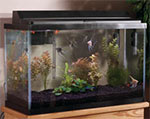The Importance of a Quarantine Tank
The practice of quarantining new aquarium arrivals is a fundamental part of proper aquarium husbandry. Surprisingly, many aquarium hobbyists either forget or do not quarantine new aquarium additions. Quarantine tanks should be used by all members of the aquarium hobby prior to introducing any new aquatic life.
Every time we introduce new aquatic life to our aquarium, there is always the potential of also introducing unwanted parasites or disease-causing organisms. In addition, aquatic life stressed from transport and relocation are more susceptible to succumbing to any parasites or disease-causing organisms present in the new environment. Therefore, a quarantine tank is a vital piece of equipment all aquarists need to investment in to protect new AND existing aquatic life.

Why don't all aquarists have quarantine tanks?
Many aquarists don't have a quarantine tank because of the perceived burden of maintenance and expense of the quarantine tank. However, a quarantine tank doesn't need to be large or expensive, and in the end it will pay for itself many times over. In fact, once aquarists get into the habit of using a quarantine tank, they are so impressed with the benefits and uses that they would never be without one.
What are the benefits of quarantine tanks?
In addition to minimizing the potential spread of infectious disease, quarantine tanks boast many other practical uses. After all, they are basically an "extra" aquarium that's ready for use. As part of the quarantine process, they can be used to condition new fish to new water parameters as well as diet in a safe, stress free environment.
When not in use for quarantine, these tanks can also double as treatment tanks. Medicating or treating the entire aquarium display for a problem that affects only a few fish is not good practice. Quarantine tanks allow only the infected fish to be treated, leaving sensitive species or water quality in the main display aquarium unaffected by medications. Other uses for quarantine tanks include a breeding tank for fish, a recovery tank for harassed fish, or a "grow out" tank that allow newly hatched fry to mature in safety.
What size quarantine tank should I use?
A 29-gallon tank makes an excellent quarantine tank and is perfect for most freshwater and saltwater applications. However, a slightly larger or smaller tank can work as well.
What equipment do I need for my quarantine tank?
Most quarantine tanks are set up with lighting, a heater, easy-to-clean rocks, and pvc tubes or plastic plants to provide the fish with much-needed cover. For filtration, a sponge filter works well and the sponge can be colonized with nitrifying bacteria by placing it in the sump of your wet dry filter, or in the main display if a sump isn't available. Make sure to disinfect and rinse well between uses. Substrate is unnecessary and not having substrate keeps cleaning and disinfecting quarantine tanks easy.
How do I disinfect my quarantine tank?
Aquariums and equipment can be disinfected between uses with a mild (2-5%) bleach solution. Make sure all traces of bleach are rinsed off before re-using. As an added precaution, use a chlorine neutralizer to effectively remove any potential residual chlorine. Drying also kills many but not all aquatic pathogens. Make sure to have a separate siphon for your quarantine tank and disinfect it as well between uses.
How long should I quarantine my fish?
Most hobbyists will keep their fish in quarantine for at least 2 to 4 weeks. During that time, they often treat for parasites with a copper-based treatment for 14-21 days, and only treat for bacterial infections if there are obvious symptoms (ragged fins, red spots, etc.). Make sure to perform a 10-15% water change every other day to keep the inhabitants of the quarantine tank healthy.
